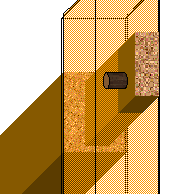|
Learning as Loss 1
Subject Teacher Learner The Great Stirrup Controversy 1 Tutoring theory 1 Skeletons and Shells 1
|
No need to take notes � they'll be on the website
Technology and the culture
of
learning and teaching
This is a revised version of a paper given at a plenary session of the Spring Symposium of the De Montfort University PGCE/Cert Ed (Post Compulsory Education) course, 11 April 2001. The buzz-group feedback has been drawn on within the main text, and certain images have not been used, to respect copyright. My thanks to the other participants who contributed to the original paper.
In this paper I want to explore some aspects of the impact of technology on learning and teaching � not just the "new" technologies, although they present us with some interesting challenges. The title is accurate � as this version of the paper shows � but it also represents a shift in our conventional understanding of "lectures" and how we as listeners might respond to them. I have to admit, however, that I shall be painting with a broad brush here. You may well find things to object to in the detail, but I hope that such disagreements will not detract too much from the main point of the argument. Where the account appears to be male-dominated, that is a reflection of the reality described.
Illuminated manuscripts
Technology is not neutral
We tend to think of technology as a kind of passive servant, which solves problems which we define, and for which it was invented. We are much less comfortable with its unintended consequences, which may be both subtle and profound.
The historian Lynn White Jr. suggested that feudalism in Western Europe came about through the introduction of the stirrup. Having shown that it was a remarkably rapid social innovation, becoming the norm in France in about fifty years, he traces the stimulus to the arrival of the stirrup from the East. Horse riders without stirrups may be very accomplished, but they are relatively easily unseated, especially in battle, so the role of the horse was limited � pre-stirrup � mainly to transporting men to the battle. They then dismounted or were unseated and fought on foot. The stirrup made them much more stable and welded rider and horse into a new kind of fighting machine. With stirrups the knight � as he became � could wield a two-handed broadsword, an battle-axe or even a lance with a much better chance of retaining his balance.
The Great Stirrup Controversy
So far, straightforward. But war-horses needed to be heavy and powerful beasts, bred and trained for the fray. Their riders needed armour, beyond mere chain-mail, which was expensive. New forms of social and economic organisation were needed to fund and support more technologically sophisticated war-bands: the motley pike-men of the manor supported by a few mercenaries were no longer sufficient to defend the land.
The scene was set for the creation of the legitimised protection-racket known as the fedual system, with its panoply of nobility and rank and vassalage and castles and hovels � all because of the stirrup. The current consensus is that White over-stated his case, but unforeseen knock-on effects are still real.
It could be argued that if the railroads really opened up the American West, its actual settlement and the form of that settlement owes more to the availability of cheap nails and standard-sized pre-sawn lumber than to practically anything else. The standard method of building timber-framed houses in the relatively settled East had been post-and-beam construction � based on the mortice and tenon jointing of major structural timbers, as illustrated right. It is slow and skilled work, but able to make use of non-standard timbers, and does not need any metal fixings.

POLLAN M (1998) A Place of My Own: the education of an amateur builder London: Bloomsbury
CRONON W (1991) Nature's Metropolis: Chicago and the great West New York; W W Norton
White settlers in the mid-West did not have skilled carpenters available � or many trees. They needed to be able to knock together a sturdy house as quickly as possible, probably with just one or two relatively unskilled men working on the construction of the frames, and with the assistance of scattered neighbours for their "raising". Pre-sawn timber from the lumber-mills of Chicago, transported by train, and fixed with cheap mass-produced nails, made it all possible, and hence settled the West � rapidly and providing opportunities to groups which would never have been able to establish themselves with the older methods of house- and barn-building.
Numerous commentators have pointed out the radical changes brought about by the invention of printing. It was not merely a matter of making books available more cheaply to a wider population � since most people could not read at the time, that of itself was hardly relevant. But it did put literacy on the social agenda, and in the process brought to the fore a form of education which did not rely solely on passing on the wisdom of the local elders. Among the more radical interpretations, Marshall McLuhan suggested that it elevated the visual sense above the others � particularly the aural. It accustomed new readers to the sequential presentation of ideas, rather than the instantaneous imagery of pictures � but it also made literacy a prime determinant of social opportunity. The ripples are social tsunami.
http://members.global2000
.net/~dporush/HTML%20FIles
/McLuhan's%20GG.html
Education and Technology
Very interesting, but what has this got to do with education?
In the presentation, we got at the answer to this question in syndicate groups. Each group was given an item of educational technology, and given 10 minutes to respond to the following question:
What effect does a teaching and learning system based on this technology have on:
- practice in learning and teaching
- social relations in the classroom, and
- the nature of learning and knowledge?
The items were:
- a piece of chalk
- an overhead projector transparency (viewfoil) (2 groups)
- a handout (2 groups)
- a CD-ROM encyclopaedia
- a flipchart
The following discussion draws on the answers from the groups, without simply repeating them. Feel free to try the exercise yourself before proceeding.
©
James Atherton
last updated
21 April 2001

